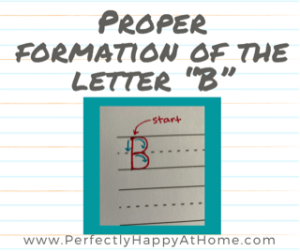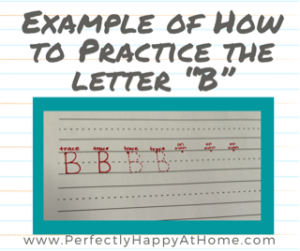 Handwriting is one of those subjects that many homeschoolers are unsure whether they should focus on, or not. I mean, does penmanship really matter in this day and age, with all the typing and texting? This is another question I am asked regularly as a teacher. Here is my humble, but outspoken, opinion on the matter.
Handwriting is one of those subjects that many homeschoolers are unsure whether they should focus on, or not. I mean, does penmanship really matter in this day and age, with all the typing and texting? This is another question I am asked regularly as a teacher. Here is my humble, but outspoken, opinion on the matter.
EMPHATICALLY, YES. It matters quite a bit, actually!
Let’s start at the hypothetical beginning of a child’s education. What is one of the first things most children are taught, no matter where they begin their school years?? The alphabet. You know the song. Something that probably doesn’t surprise you in the least is that many children already know this song before they have even started their formal learning. Remember the classic letter called “ellemenohpeeee”? Once they begin school and see the letters individually, this single, gigantic letter in the song often self-corrects, and children begin singing the correct version as “L, M, N, O, P…” instead. This is because they can now see, hear, and recognize that each individual letter has its own value and stature.
Moving ahead to the beginning of learning to write. When children are taught the shapes of the letters, it is vital that proper formation of the letter be taught. This seems like a tedious process, but I promise that it is worth every moment you spend on it. Although many parents are of the opinion that “just getting the letter on the paper to LOOK kind of like the actual letter” is good enough, this is not usually the case. For instance, please visualize this procedure with me. A child who can write a letter “B” on the page by starting at the top, making a straight line downwards, then picking up the pencil and placing back at the beginning mark to make the two “bumps” of the “B” is going to have an easier time identifying the letter, reading the letter, and writing the letter quickly. This is one of the widely-used proper penmanship processes for making the letter. Conversely, a child who attempts to make the same letter by making a “snowman” shape by stacking two individual circles, and then painstakingly tries to connect them with a straight line on the left side (this is not known as a proper way to make the letter), is likely to have a harder time identifying, reading the letter, and certainly a slower time writing it. Here are some fantastic resources for you on the importance of penmanship, and its correlation to reading, writing skills, and even math!
5 Ways Research Supports the Power of Penmanship! (zaner-bloser.com)
Better learning through handwriting — ScienceDaily
All this to say that proper letter formation is key to both good, legible writing AND reading skills. Ideally, these penmanship skills are taught and learned this way from the very beginning, and practiced through fun games and drills when kids are in Kindergarten and First Grade. This is my favorite publisher to use for handwriting skills. It is the easiest way I have found to teach great handwriting skills. But I know that this isn’t always possible for many reasons, and sometimes we end up with a Fifth Grader whose writing is nearly illegible. Don’t panic! It’s not too late! There is always hope!
What do you do if your older student has not learned good technique? There are several ways to go here. Yay for options!
 Option 1: Remediate your student’s penmanship by going back a teaching how to form each letter. Have them practice letter by letter, line by line, just like they would have had they learned it the first time around. While there are some older kids who will be fine with this method, there will be others who balk at it, arguing that it’s the “baby” way. Never fear, mama! I’ve got yo on this one! (See the next option.)
Option 1: Remediate your student’s penmanship by going back a teaching how to form each letter. Have them practice letter by letter, line by line, just like they would have had they learned it the first time around. While there are some older kids who will be fine with this method, there will be others who balk at it, arguing that it’s the “baby” way. Never fear, mama! I’ve got yo on this one! (See the next option.)
Option 2: Skip further instruction on printing altogether, and move straight into teaching cursive properly. Yes, I said cursive. As a teacher, I feel there is much value in learning and practicing cursive. Many times, learning it will automatically correct a student’s poor printing penmanship by default. Another thing that can tend to happen is the student realizing that cursive is faster and opting on his/her own to use it as the primary writing style. Cool beans!
Option 3: This one is for the older student who is VERY reluctant/doesn’t care at all what the words written on the page come out looking like. They don’t see the value, don’t care about the value, and/or feel it’s a waste of time to improve their penmanship. This is a tricky one! It is so dependent on the individual situation. If your child is a lot older…now I am speaking from the mama point of view…pick your battles. While penmanship is very important as a component of essay and creative writing, reading comprehension, etc., if it will cause a rift in your relationship with your son or daughter, always choose love first. What is the most loving way to help him/her? To work together on a remedy that is acceptable to both of you? To drop the subject completely and let it be what it is? (I usually suggest this only if the student reads and comprehends the reading proficiently.) To drop the hammer and make it get done to drive home the practice of excellence? These are the questions I cannot answer. But I know you can!
 To sum up today’s Teacher Tip on penmanship, I will leave you with this: It is best to teach correct letter formation and penmanship from the beginning. If this isn’t possible, or didn’t happen, remediate and reteach when possible. If this isn’t possible, love them where they are, and work around difficulties. Sometimes, finding the joy in teaching our children is so easy. Sometimes it isn’t. Just like everyday, I will always be encouraging you to seek it though. It is so important, to your well-being and your children’s. Sending you off with prayers for a day filled with love.
To sum up today’s Teacher Tip on penmanship, I will leave you with this: It is best to teach correct letter formation and penmanship from the beginning. If this isn’t possible, or didn’t happen, remediate and reteach when possible. If this isn’t possible, love them where they are, and work around difficulties. Sometimes, finding the joy in teaching our children is so easy. Sometimes it isn’t. Just like everyday, I will always be encouraging you to seek it though. It is so important, to your well-being and your children’s. Sending you off with prayers for a day filled with love.
Lastly, here are some fun items I like to use with younger kids for encouragement when handwriting maybe isn’t so much fun:
